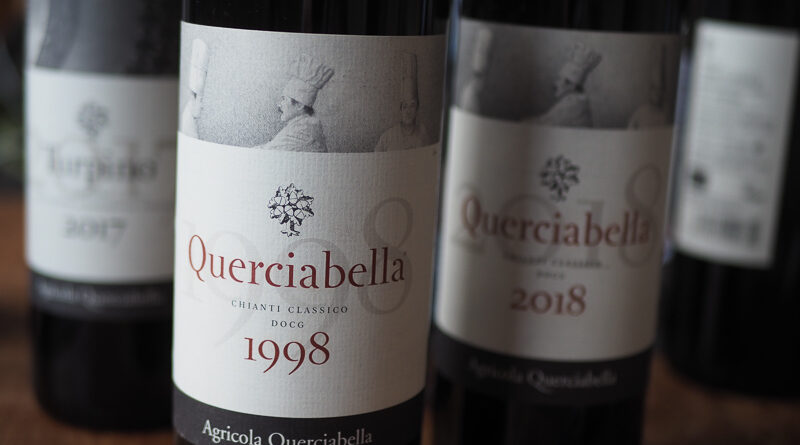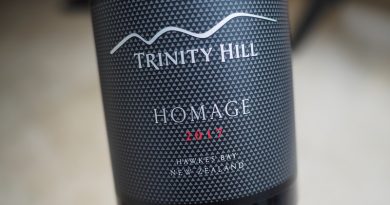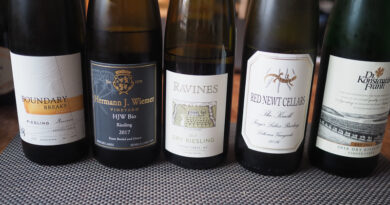Querciabella, one of Tuscany’s top wineries, who employ vegan biodynamics
Querciabella was founded in 1974 by Giuseppe (Pepito) Castiglioni, who had made money in steel and had fallen in love with the wines of France. Here, in Chianti Classico, he wanted to take inspiration from Burgundy, among other places, but with a Tuscan twist. Batàr, the famed white wine of Querciabella, was clearly inspired by white Burgundy. From small beginnings of just a hectare, he began adding vineyards, buying sites in Panzano, Radda and Gaiole.
Things took off when his son Sebastiano Castiglioni took over in the 1990s. The organic farming that had been adopted progressed to biodynamics, and as well as the 74 hectares in Chianti Classico, Querciabella got their hands on 32 hectares in Maremma.
The latest shift is that they have moved from biodynamics to what they call Vegan Biodynamics, which doesn’t involve any animals – some of the biodynamic preparations have animal content, and also some of them are matured underground after being packed into cow horns: Querciabella now use ceramic horns.
I caught up with winemaker Manfred Ing to taste through some of their wines, including a vertical of Batàr.
Manfred Ing is from South Africa, born and raised in Pietermaritzburg in KwaZulu-Natal. He studied in Stellenbosch and then started travelling. ‘I was a bit of a harvest junkie,’ he says. ‘I wanted to get as much information as I could, and I was doing the southern hemisphere harvest followed by the northern hemisphere harvest. South Africa, New Zealand, Napa Valley, Barolo.’ He ended up living in New Zealand for 18 months, based at Peregrine in Central Otago. ‘It was just too far away to live,’ he says. ‘No one comes to visit you.’
He ended up returning to Europe and did a vintage at Vietti (Barolo) in 2009. He then came down through Tuscany, and one of his visits was at Querciabella. He had lunch and Sebastiano asked him to join. This was in 2010 and he’s been here since. He was 25 when he joined.
The evolution of Querciabella’s viticulture started back in the late 1980s when Sebastiano decided to convert to organics. ‘We have been certified organic since 2000, says Manfred. But in 1999 Sebastiano Castiglioni attended a biodynamic wine tasting in Milan and was overwhelmed by the concept.’ From 2000 they have been biodynamic. They took on a biodynamic consultant and for 10 years practiced traditional biodynamics, with all the different preparations. But now they are practicing vegan biodynamics.
Sebastiano is a lifelong vegetarian, and had decided to become a vegan. ‘He was convinced that we didn’t need to use any animal products or by products in any aspect of our production,’ says Manfred. ‘We eliminated the cow horn and animal manure, and we do everything with green manure and cover crops.’ Instead of using a compost that contains animal waste, they make a green compost composed only of plant material.
These cover crops are sown in alternating rows, and the make-up is determined by the perceived needs of each block. ‘Our agronomist, Dales D’Alessandro, has been here since 1998, and he’s followed the production and knows the vineyards incredibly well,’ says Manfred. ‘Obviously, the climate is changing and the soils are changing, and we have been acquiring new vineyards even since I’ve been here. We now have 75 hectares in Chianti Classico – when I arrived we were sitting around 40 hectares. Things are evolving but the essence of the cover crops are the legumes, the brassicas, the spicy leaf stuff and the different types of grains. We have poor soils: our vineyards here [in Ruffoli in Greve, where the winery is] are growing on galestro, which are sedimentary schists. We also have these soils in Radda, and in Gaiole we have albarese, which is limestone. On the hillside of Ruffoli it is predominantly galestro, but at the highest vineyards they are galestro but there is a lot of big sandstone. In our lowest vineyards there is a higher percentage of clay.’
‘The goal for us is biodiversity,’ says Manfred. ‘We are trying to get as much biodiversity between the rows. The cover crops are changing every year.’
One aspect of biodiversity that is less welcome is the incursion of wild boar into the vineyards close to harvest time. ‘Unfortunately we have a massive problem with wild boar,’ says Manfred. ‘The animals are no longer staying up in the hills. This is quite a big problem, because all our vineyards are surrounded by forests. They are all surrounded by fences.’
THE WINES
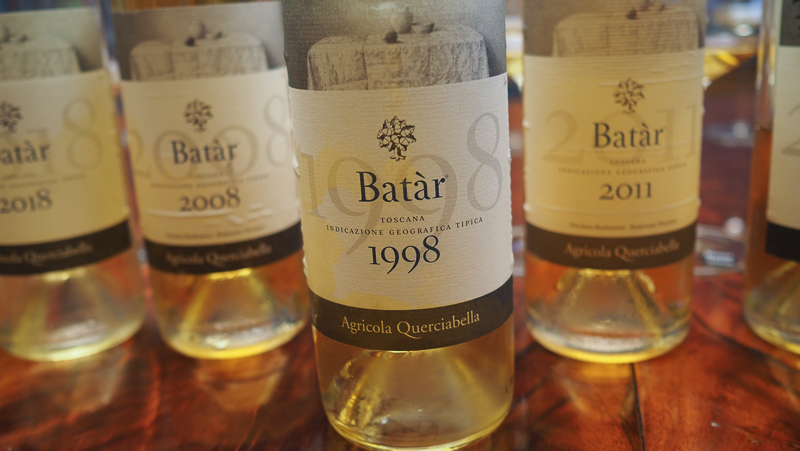
Batàr
This was first made in 1988, when it was called Bâtard-Pinot. It’s a blend of Pinot Blanc and Pinot Gris. The name was changed in 1992 to Bâtard, and Chardonnay was added to the blend. Then in 1995 it was Batàr to avoid problems with the Burgundian word Bâtard. In Tuscany, white wine hasn’t been taken very seriously, but this wine was the first white Supertuscan.
‘The vineyards are within 2 km of the winery,’ says Manfred. ‘We pick early in the morning and fill the press by 10 am.’ The grapes are whole bunch pressed, and the juice is settled overnight. It is racked into 225 and 500 litre barrels for fermentation. Post ferment, they warm the room a bit and the wine undergoes full malolactic fermentation, then it is sulfured and sits on gross lees for 9-10 months.
From 2010 onwards there was less new oak (10-15%). Some of the older vintages had 60-70% new oak.
Querciabella Batàr 2018 Tuscany, Italy
Typical of Bàtar, says Manfred Ing. It’s starting to come out of its hollow phase. This is quite tight but has lovely pear and peach notes, as well as some citrus. It’s quite nutty and rounded too with lovely texture. So refined and smooth, but with a lovely mineral, acid core that suggests there’s potential for development. Nice refinement and some fine spiciness alongside the fruit. 94/100
Querciabella Batàr 2017 Tuscany, Italy
13.5% alcohol. This is powerful and complex with nuts, honey, spice and ripe pear and peach fruit on the nose. The palate is rich and layered with crystalline citrus fruit, some lovely grape and pear richness, and also a steely citrus and mineral undercurrent that hints at great things to come. A real mix of flavours here, with a long, spicy finish. There’s also some jasmine character here: really hard to capture in words. 95/100
Querciabella Batàr 2013 Tuscany, Italy
Complex aromatics of honey, some toast and some cabbage, with fine spiciness. The palate is broad and refined, showing lovely depth, but also freshness and vitality. The richness here is present, but it’s held in beautiful tension with some spicy minerality and freshness, with a long spicy finish. Great concentration, and also lovely freshness. It’s still a baby at age 8, with further distance to go. Lovely wine. 95/100
Querciabella Batàr 2011 Tuscany, Italy
Full yellow/gold colour. Warm, dry vintage. Rich nose of toast and pear with some baked apple notes and fine spiciness. The palate is rich and powerful with nuts, spice and honey, and a lovely mineral undercurrent to the generous, smooth fruit. It’s rich and peachy, with a grapey touch, showing lovely richness and almost and oiliness to the fruit. This has a really nice mineral undercurrant that runs through the finish, with complex spiciness. 94/100
Querciabella Batàr 2008 Tuscany, Italy
Yellow/gold in colour. Some restraint on the nose: fine almond and hazelnut with ripe pear and citrus, and a touch of spice. The palate is fresh and detailed with nice brightness, a fine spicy minerality, nuts and honey, and lovely ripe pear and peach fruit. Shows nice restraint and still relatively youthful. Notes of toast and marzipan, too. I love the freshness here – it doesn’t show its 50% new oak. 95/100
Querciabella Batàr 2002 Tuscany, Italy
Mainly Pinot Bianco, and this is a bit of an outlier. It was a difficult vintage, with lots of rain. Volumes were down, and the Chardonnay suffered very badly. Full golden colour. Hints of mint, nuts and medicine on the nose with some toasty depth. The palate is fresh and quite powerful with sweet lemons and dried herbs, some more toast and almond, and a bit of grip. There’s a freshness on the finish, and some structure and even some earthiness on the finish. Made in a slightly oxidative style it has a spicy savouriness and a touch of apricot, too. 92/100
Querciabella Batàr 1998 Tuscany, Italy
13% alcohol. Yellow gold in colour, this is ageing very well. It’s really complex, with notes of plum and spice with some yellow plum and peach, a touch of apricot, some mineral notes and a nice acid line. Layers of flavour here with real complexity: yellow fruits but also some citrus, and fine spicy, minerally notes – you’d never guess this was 23 years old. Very fine and expressive. 96/100
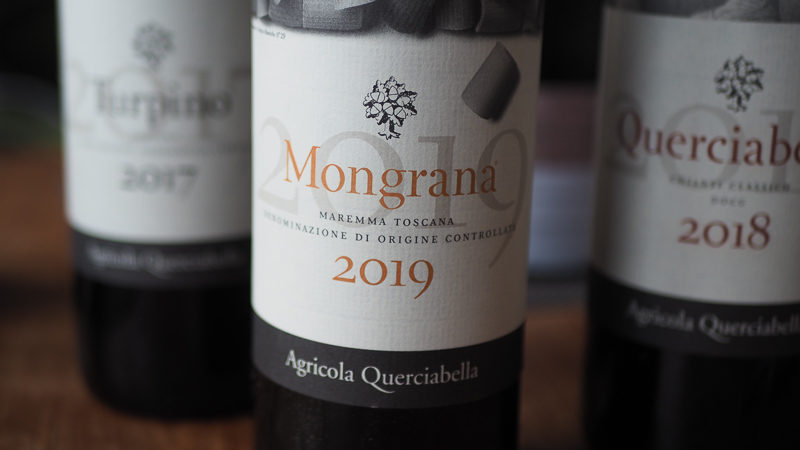
Querciabella Mongrana 2019 Maremma Toscana, Italy
14% alcohol. Sangiovese (50%) with Cabernet Sauvignon and Merlot (25% each), matured in cement and stainless steel. Vivid, bright and fruity on the nose with black cherry and blackberry, as well as hints of tar, green herbs and spice. The palate is supple and fruit forward with fleshy but focused black fruits and a nice green, slightly tannic framing. Stylish, a little stony, with compact but ripe fruit, and nice drinkability. Sweetly fruited, berryish and a bit crunchy. 91/100
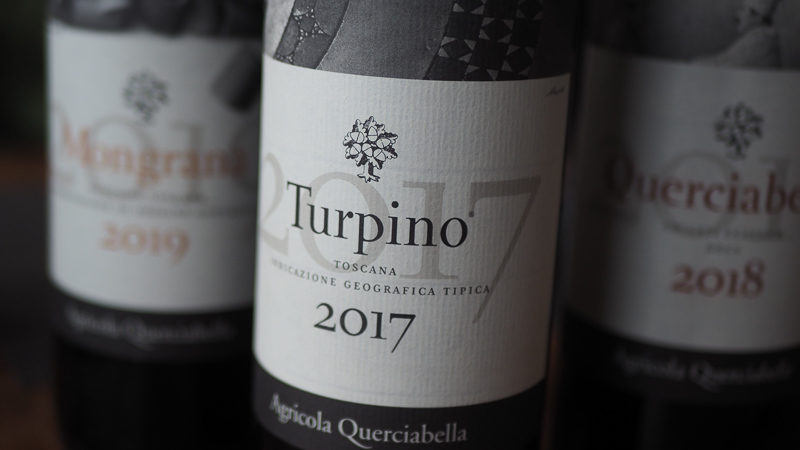
Querciabella Turpino 2017 IGT Toscana, Italy
14.5% alcohol. Cabernet Franc, Syrah and Merlot. This is aromatic and sweetly fruited with black cherries, blackberries and some sleek blackcurrant notes. There’s a lot of aromatic fruit here, but it isn’t jammy. Very smooth and ripe with nice texture, and a fine-grained tannic structure. This has lushness, smoothness and nice weight, finishing with some subtle tar and gravel notes, as well as a warm balsamic twist. Stylish stuff, with more depth and ripeness than the Chianti Classico wines, offering a more immediate pleasure. 93/100
Querciabella Chianti Classico 2017 Tuscany, Italy
13.5% alcohol. First made in 1974, this is 100% Sangiovese from biodynamically farmed vineyards (since 2000, organic since 1988). Cherry red in colour, this is a really beautiful expression of Sangiovese with fine cherry, redcurrant and berry fruit, a dusty tannic structure, as well as notes of leather, juniper and dried herbs. There are lovely contrasts here between the fine, floral silky red fruits and the fairly substantial structure from the tannins and acidity. Such finesse, and quite a bit of ageing potential. It’s not an easy wine, nor is it seductive, but it has beauty. 94/100
Querciabella Chianti Classico 2018 Tuscany, Italy
Fine and expressive on the nose: really focused cherry and plum fruit with fine green notes and lovely aromas. The palate is supremely fresh and balanced with lovely focus to the fresh, elegant red berry fruits, as well as nice herby, slightly spicy complexity. Really bright and expressive. 95/100
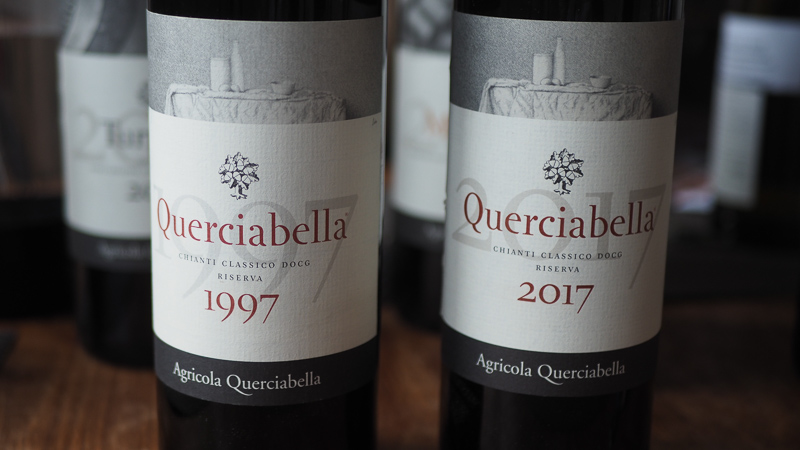
Querciabella Chianti Classico Riserva 2017 Tuscany, Italy
14% alcohol. First made in 2011. Very fine and detailed, but also dense and full flavoured, with fine black cherry and blackberry fruit with some dusty strawberry notes on the nose. The palate has great concentration and good structure, but no rusticity. There’s a touch of damson and a hint of balsamic on the finish, giving a savoury buttressing to the fruit, but everything is in place: dry, fine grained tannins, good acidity, plenty of vivid fruit and the potential for a long development in bottle. Has a real grip to it: this is benchmark Sangiovese from good terroirs. 95/100
Querciabella Chianti Classico 1998 Tuscany, Italy
12.5% alcohol. Beautiful aromatics of tar, spice, blackcurrant, gravel, fine herbs and cherry. Mature and showing evolution, but with freshness and nice ripe fruit. The palate is supple and bright but with some lovely notes of maturity: blackcurrant, earth, spice and orange peel, as well as dried herbs and some wild strawberry. Shows firm tannic structure and a drying finish, but still with lots of black fruits and notes of cedar and iodine, tar and spice. Evolving really nicely, and still with some real grip. 94/100
Querciabella Camartina 2016 IGT Toscana, Italy
13.5% alcohol. Brooding, fine and intense with sweet blackcurrant fruit that still has some spicy, structured sternness. There’s a delicious savoury grip here and a very faint balsamic note countering the fresh, tannic blackcurrant and black cherry notes. Brooding and really intense, and quite impressive. Finishes dry and taut, but there’s some much potential here for future development. This is a serious wine that holds up impeccably over three days after opening. It will go the distance. 95/100
Querciabella Camartina 2008 IGT Toscana, Italy
14% alcohol. This is 70% Cabernet Sauvignon, 30% Sangiovese. Mature and harmonious bit with some stuffing, showing a jammy edge to the smooth blackcurrant and black cherry fruit, with molten tannins and notes of earth, stone and blood. Very fine and detailed with a nice spiciness and lush but structured fruit. 94/100
Querciabella Camartina 2003 IGT Toscana, Italy
14% alcohol. This is highly aromatic with a strong balsamic note on the nose, showing spice, tar and sweet black fruits. On the palate it is structured and dry with firm tannins under the sweet fruit. There’s a savoury element here, and some grip on the finish, but also lovely sweet black fruits. It has a charry, charcoal and tar edge and it would be perfect with rare steak. The product of a hot vintage, there’s certainly a dry tannic edge here, but it works really well. 94/100
Find these wines with wine-searcher.com

